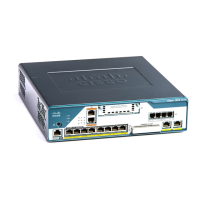Differential Clock Recovery (DCR)
Differential Clock Recovery (DCR) is another technique used for Circuit Emulation (CEM) to recover clocks
based on the difference between PE clocks. TDM clock frequency are tuned to receive differential timing
messages from the sending end to the receiving end. A traceable clock is used at each end, which ensures the
recovered clock is not affected by packet transfer.
Benefits of Clock Recovery
• Customer-edge devices (CEs) can have different clock from that of the Provide-edge devices (PEs).
• In CESoPSN, a slave clock is supported for clock redundancy.
Scaling Information
Pseudowires Supported (Number of Clocks Derived)IM Card
4848-Port T1/E1 CEM Interface Module
48-Port T1/E1 CEM Interface Module Configuration Guide, Cisco IOS XE Fuji 16.7.x (Cisco NCS 4200 Series)
32
Clock Recovery System for SAToP
Differential Clock Recovery (DCR)

